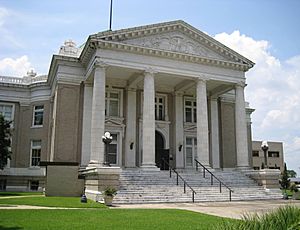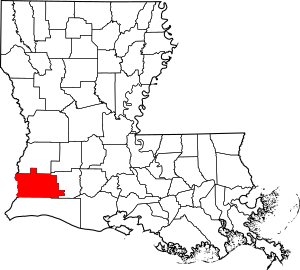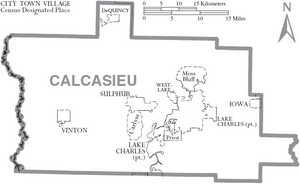Calcasieu Parish, Louisiana facts for kids
Quick facts for kids
Calcasieu Parish, Louisiana
|
|
|---|---|
| Parish of Calcasieu | |

Calcasieu Parish District Courthouse
|
|

Location within the U.S. state of Louisiana
|
|

Louisiana's location within the U.S.
|
|
| Country | |
| State | |
| Region | Acadiana |
| Founded | March 24, 1840 |
| Named for | Atakapa leader Katkōsh Yōk ('Crying Eagle') |
| Parish seat (and largest city) | Lake Charles |
| Area | |
| • Total | 2,830 km2 (1,094 sq mi) |
| • Land | 2,760 km2 (1,064 sq mi) |
| • Water | 80 km2 (31 sq mi) 2.8% |
| Population
(2020)
|
|
| • Total | 216,785 |
| • Rank | LA: 7th |
| • Density | 76.51/km2 (198.16/sq mi) |
| Time zone | UTC-6 (CST) |
| • Summer (DST) | UTC-5 (CDT) |
| Congressional district | 3rd |
Calcasieu Parish is a special kind of county in the southwestern part of Louisiana. It's located right on the border with Texas. In 2020, about 216,785 people lived here. The main city and the place where the local government is located is Lake Charles.
Calcasieu Parish is part of the larger Lake Charles city area. It's also close to other big cities like Beaumont–Port Arthur in Texas, and Lafayette and Alexandria in Louisiana.
Calcasieu Parish was created on March 24, 1840. It was formed from a part of Saint Landry Parish. Saint Landry was one of the first 19 parishes set up by the Louisiana government in 1807. This happened after the United States bought the land in the Louisiana Purchase of 1803. The first parish seat was a place called Comasaque Bluff, which was later renamed Marion.
In 1852, a local businessman named Jacob Ryan gave land to move the parish seat to Lake Charles. As more people moved to the area, the original Calcasieu Parish became too big. It was later divided into five smaller parishes. The original large area is now known as "Imperial Calcasieu."
Contents
What's in a Name? The Story of Calcasieu
The name Calcasieu comes from the Atakapa language. It was passed into French and then English. It's believed to be named after a local Atakapa leader called Katkōsh Yōk, which means 'Crying Eagle'.
You might see the name spelled in different ways in old writings, like Quelqueshue or Calcasiew. The oldest known version, rivieére Calkousiouk, was written in 1807.
A Look Back: History of Calcasieu Parish
Early Times
The story of Calcasieu Parish goes back to when Spain controlled Louisiana. This was after France lost the territory in a big war called the Seven Years' War. In 1797, a large piece of land between the Calcasieu River and the Sabine River was given to Jose M. Mora. This area was known as the "Neutral Strip" because both Spain and the United States argued over who owned it. It became a place where outlaws and adventurers would hide.
The United States finally gained control of this land from Spain in 1819 with a treaty. By 1823, this strip of land became part of the Louisiana Territory.
Early families who settled here included the Ryan, Perkin, and LeBleu families. People from Acadia (now eastern Canada) also moved here. They were French-speaking settlers who had been forced to leave their homes by the British. The parish had a mix of people: French and Spanish Creoles, Acadians, English-speaking Americans, and Native Americans. Some African Americans, both free and enslaved, also lived in the area.
The "Imperial Calcasieu" Era
Calcasieu Parish was created in 1840 from Saint Landry Parish. It was the largest parish in Louisiana, even bigger than the states of Delaware and Rhode Island! Because of its huge size, people started calling it "Imperial Calcasieu."
On August 24, 1840, six men met to start the local government, called the police jury. They chose leaders and set up rules. They also hired people to manage the parish, like a treasurer and assessors.
In December 1840, they decided to name the parish seat Marion. But in 1852, Jacob Ryan helped move the parish seat to the east bank of Lake Charles. This new town was first called Charleston in 1857, then renamed Lake Charles in 1868. The name Lake Charles honors Charles Sallier, one of the first European settlers in the early 1800s.
Dividing the Big Parish
In 1870, Cameron Parish was created from the southern part of Imperial Calcasieu. This was done to help spread out political power. Unlike other parts of Louisiana that had many large farms with enslaved workers, Calcasieu Parish was mostly used for raising cattle. So, it had fewer enslaved people than other areas.
By 1912, Calcasieu Parish was still very large, covering over 3,600 square miles. That year, "Imperial Calcasieu" was divided even more. Three new parishes were created: Allen, Beauregard, and Jefferson Davis. This made Calcasieu Parish much smaller, and its population dropped by almost half between 1910 and 1920.
Geography of Calcasieu Parish
Calcasieu Parish covers about 1,094 square miles. Most of this is land (1,064 square miles), and about 31 square miles (2.8%) is water.
Main Roads
 Interstate 10
Interstate 10
 U.S. Highway 90
U.S. Highway 90 U.S. Highway 165
U.S. Highway 165 U.S. Highway 171
U.S. Highway 171 Louisiana Highway 12
Louisiana Highway 12 Louisiana Highway 14
Louisiana Highway 14 Louisiana Highway 27
Louisiana Highway 27
Neighboring Areas
- Beauregard Parish (north)
- Jefferson Davis Parish (east)
- Cameron Parish (south)
- Orange County, Texas (west)
- Newton County, Texas (northwest)
Major Waterways
- Lake Charles
- Calcasieu River
- Intracoastal Canal
- Ouiski Chitto Creek
- English Bayou
- West Fork
- Calcasieu Lake
Communities in Calcasieu Parish
Cities
- DeQuincy
- Lake Charles (This is the main city and where the parish government is.)
- Sulphur
- Westlake
Towns
Other Communities
Who Lives Here? Demographics
| Historical population | |||
|---|---|---|---|
| Census | Pop. | %± | |
| 1840 | 2,057 | — | |
| 1850 | 3,914 | 90.3% | |
| 1860 | 5,928 | 51.5% | |
| 1870 | 6,733 | 13.6% | |
| 1880 | 12,484 | 85.4% | |
| 1890 | 20,176 | 61.6% | |
| 1900 | 30,428 | 50.8% | |
| 1910 | 62,767 | 106.3% | |
| 1920 | 32,807 | −47.7% | |
| 1930 | 41,963 | 27.9% | |
| 1940 | 56,506 | 34.7% | |
| 1950 | 89,635 | 58.6% | |
| 1960 | 145,475 | 62.3% | |
| 1970 | 145,415 | 0.0% | |
| 1980 | 167,223 | 15.0% | |
| 1990 | 168,134 | 0.5% | |
| 2000 | 183,577 | 9.2% | |
| 2010 | 192,768 | 5.0% | |
| 2020 | 216,785 | 12.5% | |
| 2021 (est.) | 205,282 | 6.5% | |
| U.S. Decennial Census 1790-1960 1900-1990 1990-2000 2010-2019 |
|||
| Race | Number | Percentage |
|---|---|---|
| White (non-Hispanic) | 137,110 | 63.25% |
| Black or African American (non-Hispanic) | 54,825 | 25.29% |
| Native American | 902 | 0.42% |
| Asian | 3,797 | 1.75% |
| Pacific Islander | 137 | 0.06% |
| Other/Mixed | 8,630 | 3.98% |
| Hispanic or Latino | 11,384 | 5.25% |
In 2020, the population of Calcasieu Parish was 216,785 people. There were about 77,232 households, which are groups of people living together.
Most people in the parish are White (about 63%). About 25% are Black or African American. There are also smaller groups of Native American, Asian, and Pacific Islander people. About 5% of the population is Hispanic or Latino.
In 2010, about 35% of households had children under 18 living with them. The average household had about 2.6 people. The median age in the parish was 34 years old. This means half the people were younger than 34, and half were older.
Education
Public schools in Calcasieu Parish are managed by the Calcasieu Parish School Board. The area is also served by Sowela Technical Community College.
National Guard
Parts of the 256th IBCT and the 139th RSG (Regional Support Group) are based in Lake Charles. These military units have been deployed to Iraq in the past.
Notable People from Calcasieu Parish
Many interesting people have come from or lived in Calcasieu Parish. Here are a few:
- Michael E. DeBakey (1908–2008), a famous heart surgeon who was the first to successfully implant an artificial heart.
- Sean Patrick Flanery (born 1965), an American actor.
- Charlie Joiner (born 1947), a former NFL wide receiver and a member of the Pro Football Hall of Fame.
- Bobby Kimball (born 1947), the original lead singer of the band Toto.
- Tony Kushner (born 1956), a playwright who won a Pulitzer Prize.
- Zachary Levi (born 1980), an American actor and singer.
- Ted Lyons (1900–1986), a former Major League Baseball pitcher and manager, in the Baseball Hall of Fame.
- Dak Prescott (born 1993), the current quarterback for the Dallas Cowboys in the NFL.
- Rupert Richardson (1930–2008), an important African-American civil rights activist who was president of the NAACP.
See also
 In Spanish: Parroquia de Calcasieu para niños
In Spanish: Parroquia de Calcasieu para niños


